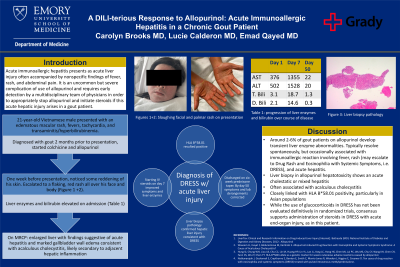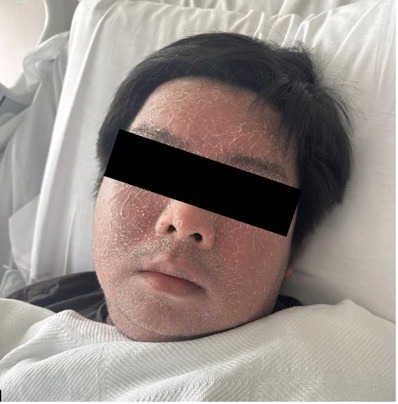Sunday Poster Session
Category: Liver
P1033 - A DILI-terious Response to Allopurinol: Acute Immunoallergic Hepatitis in Chronic Gout Patient
Sunday, October 22, 2023
3:30 PM - 7:00 PM PT
Location: Exhibit Hall

Has Audio

Carolyn G. Brooks, MD
Emory University School of Medicine
Atlanta, GA
Presenting Author(s)
Award: Presidential Poster Award
Carolyn G. Brooks, MD, Lucie F. Calderon, MD, Emad Qayed, MD, MPh
Emory University School of Medicine, Atlanta, GA
Introduction: Acute immunoallergic hepatitis presents as acute liver injury often accompanied by nonspecific findings of fever, rash, and abdominal pain. It is an uncommon but severe complication of use of allopurinol and requires early detection by a multidisciplinary team of physicians in order to appropriately stop allopurinol and initiate steroids if this acute hepatic injury arises in a gout patient.
Case Description/Methods: A 21 year old Vietnamese male with history of gout presented with edematous macular rash, fevers, tachycardia, and transaminitis/hyperbilirubinemia. He was diagnosed with gout 2 months prior to presentation and started daily allopurinol; 6 weeks later, he began to develop a diffuse, flaking erythematous rash (Figure 1). Patient’s initial AST was 376 and ALT 502; T bili was 3.1 and D bili 2.0. He did not have eosinophilia on CBC. On MRCP the patient had an enlarged liver with findings suggestive of acute hepatitis and marked gallbladder wall edema consistent with acalculous cholecystitis, due to adjacent hepatic inflammation.
Within the first week of admission, his LFTs peaked to >1300, T bili to >18 and D bili to >14 (Table 1). Patient’s LFTs and presenting symptoms improved significantly after initiating IV methylprednisolone 40 mg daily on day 6. Ultimately, the patient was found to be HLA B*58.01 positive, and liver biopsy showed hepatic pattern of injury with lobular mixed inflammatory infiltrate, consistent with DRESS syndrome with acute liver injury. He was discharged on a prednisone taper, and on outpatient follow up, his LFTs and bilirubin levels corrected to normal levels and his skin findings resolved.
Discussion: Allopurinol use for gout is associated with transient, self-resolving LFT abnormalities in 2-6% of patients; less frequently, allopurinol has been associated with immunoallergic reaction involving fever, rash (SJS/TEN or DRESS), and acute hepatitis. Although this patient had no eosinophilia, his symptoms otherwise aligned with this acute immunoallergic hepatitis. Allopurinol toxicity is associated with acute cholestatic or mixed hepatitis on liver biopsy and acalculous cholecystitis on imaging, which were both present in this patient. Allopurinol-associated DRESS with acute liver injury is also closely linked with HLA B*58.01 positivity, particularly in Asian populations. While the use of glucocorticoids in DRESS has not been evaluated definitively in randomized trials, consensus supports administration of steroids in DRESS with acute end-organ injury.

Disclosures:
Carolyn G. Brooks, MD, Lucie F. Calderon, MD, Emad Qayed, MD, MPh. P1033 - A DILI-terious Response to Allopurinol: Acute Immunoallergic Hepatitis in Chronic Gout Patient, ACG 2023 Annual Scientific Meeting Abstracts. Vancouver, BC, Canada: American College of Gastroenterology.
Carolyn G. Brooks, MD, Lucie F. Calderon, MD, Emad Qayed, MD, MPh
Emory University School of Medicine, Atlanta, GA
Introduction: Acute immunoallergic hepatitis presents as acute liver injury often accompanied by nonspecific findings of fever, rash, and abdominal pain. It is an uncommon but severe complication of use of allopurinol and requires early detection by a multidisciplinary team of physicians in order to appropriately stop allopurinol and initiate steroids if this acute hepatic injury arises in a gout patient.
Case Description/Methods: A 21 year old Vietnamese male with history of gout presented with edematous macular rash, fevers, tachycardia, and transaminitis/hyperbilirubinemia. He was diagnosed with gout 2 months prior to presentation and started daily allopurinol; 6 weeks later, he began to develop a diffuse, flaking erythematous rash (Figure 1). Patient’s initial AST was 376 and ALT 502; T bili was 3.1 and D bili 2.0. He did not have eosinophilia on CBC. On MRCP the patient had an enlarged liver with findings suggestive of acute hepatitis and marked gallbladder wall edema consistent with acalculous cholecystitis, due to adjacent hepatic inflammation.
Within the first week of admission, his LFTs peaked to >1300, T bili to >18 and D bili to >14 (Table 1). Patient’s LFTs and presenting symptoms improved significantly after initiating IV methylprednisolone 40 mg daily on day 6. Ultimately, the patient was found to be HLA B*58.01 positive, and liver biopsy showed hepatic pattern of injury with lobular mixed inflammatory infiltrate, consistent with DRESS syndrome with acute liver injury. He was discharged on a prednisone taper, and on outpatient follow up, his LFTs and bilirubin levels corrected to normal levels and his skin findings resolved.
Discussion: Allopurinol use for gout is associated with transient, self-resolving LFT abnormalities in 2-6% of patients; less frequently, allopurinol has been associated with immunoallergic reaction involving fever, rash (SJS/TEN or DRESS), and acute hepatitis. Although this patient had no eosinophilia, his symptoms otherwise aligned with this acute immunoallergic hepatitis. Allopurinol toxicity is associated with acute cholestatic or mixed hepatitis on liver biopsy and acalculous cholecystitis on imaging, which were both present in this patient. Allopurinol-associated DRESS with acute liver injury is also closely linked with HLA B*58.01 positivity, particularly in Asian populations. While the use of glucocorticoids in DRESS has not been evaluated definitively in randomized trials, consensus supports administration of steroids in DRESS with acute end-organ injury.

Figure: Figure 1: Patient's facial rash on presentation
| Day 1 | Day 7 | Day 50 | |
| AST | 376 | 1355 | 22 |
| ALT | 502 | 1528 | 20 |
| T. bili | 3.1 | 18.7 | 1.3 |
| D. bili | 2.0 | 14.6 | 0.3 |
| INR | 1.4 | 2.0 | 1.1 |
Table: Table 1: Liver function labs over duration of admission and at outpatient follow-up
Disclosures:
Carolyn Brooks indicated no relevant financial relationships.
Lucie Calderon indicated no relevant financial relationships.
Emad Qayed indicated no relevant financial relationships.
Carolyn G. Brooks, MD, Lucie F. Calderon, MD, Emad Qayed, MD, MPh. P1033 - A DILI-terious Response to Allopurinol: Acute Immunoallergic Hepatitis in Chronic Gout Patient, ACG 2023 Annual Scientific Meeting Abstracts. Vancouver, BC, Canada: American College of Gastroenterology.


